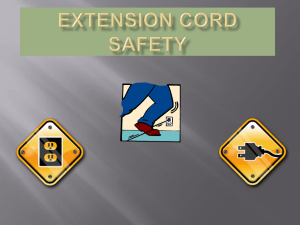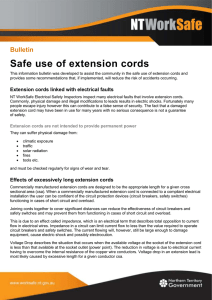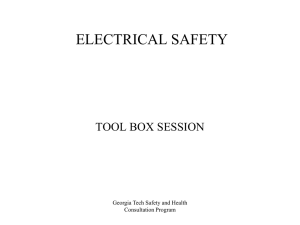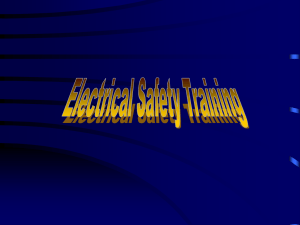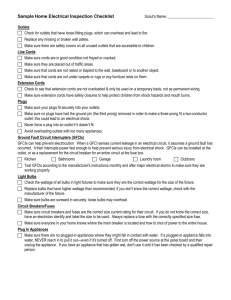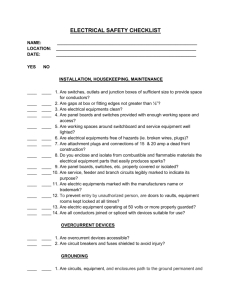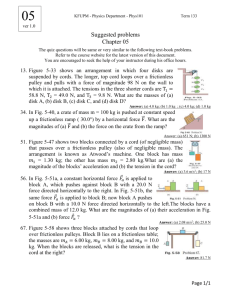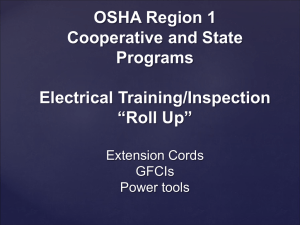Electrical Safety
advertisement
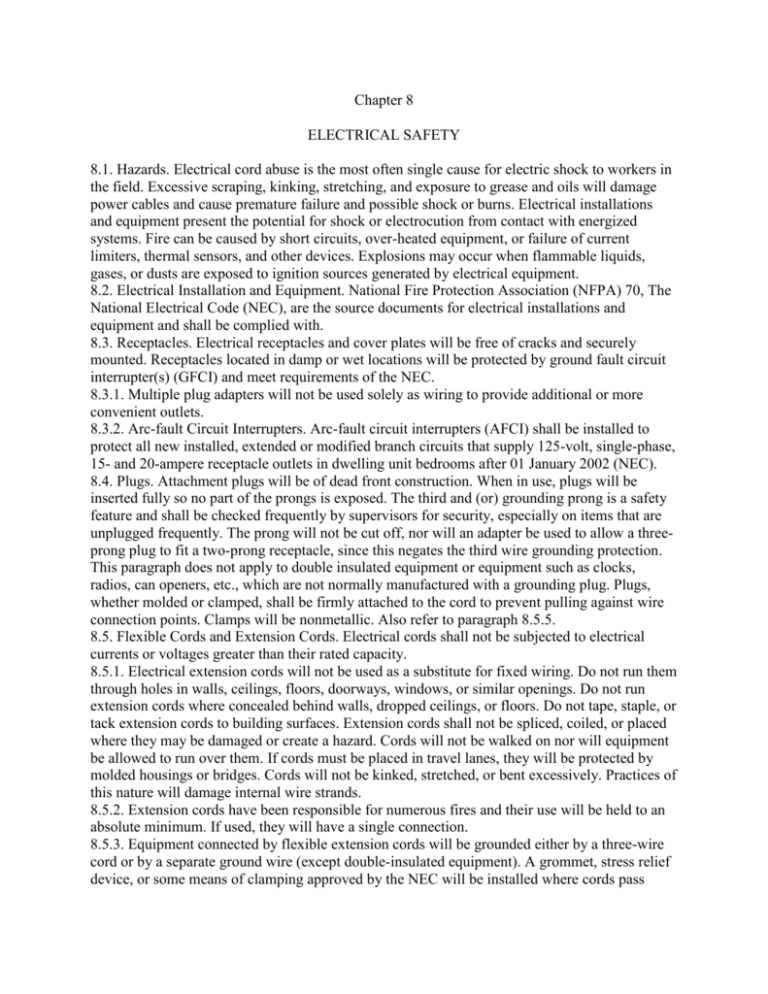
Chapter 8 ELECTRICAL SAFETY 8.1. Hazards. Electrical cord abuse is the most often single cause for electric shock to workers in the field. Excessive scraping, kinking, stretching, and exposure to grease and oils will damage power cables and cause premature failure and possible shock or burns. Electrical installations and equipment present the potential for shock or electrocution from contact with energized systems. Fire can be caused by short circuits, over-heated equipment, or failure of current limiters, thermal sensors, and other devices. Explosions may occur when flammable liquids, gases, or dusts are exposed to ignition sources generated by electrical equipment. 8.2. Electrical Installation and Equipment. National Fire Protection Association (NFPA) 70, The National Electrical Code (NEC), are the source documents for electrical installations and equipment and shall be complied with. 8.3. Receptacles. Electrical receptacles and cover plates will be free of cracks and securely mounted. Receptacles located in damp or wet locations will be protected by ground fault circuit interrupter(s) (GFCI) and meet requirements of the NEC. 8.3.1. Multiple plug adapters will not be used solely as wiring to provide additional or more convenient outlets. 8.3.2. Arc-fault Circuit Interrupters. Arc-fault circuit interrupters (AFCI) shall be installed to protect all new installed, extended or modified branch circuits that supply 125-volt, single-phase, 15- and 20-ampere receptacle outlets in dwelling unit bedrooms after 01 January 2002 (NEC). 8.4. Plugs. Attachment plugs will be of dead front construction. When in use, plugs will be inserted fully so no part of the prongs is exposed. The third and (or) grounding prong is a safety feature and shall be checked frequently by supervisors for security, especially on items that are unplugged frequently. The prong will not be cut off, nor will an adapter be used to allow a threeprong plug to fit a two-prong receptacle, since this negates the third wire grounding protection. This paragraph does not apply to double insulated equipment or equipment such as clocks, radios, can openers, etc., which are not normally manufactured with a grounding plug. Plugs, whether molded or clamped, shall be firmly attached to the cord to prevent pulling against wire connection points. Clamps will be nonmetallic. Also refer to paragraph 8.5.5. 8.5. Flexible Cords and Extension Cords. Electrical cords shall not be subjected to electrical currents or voltages greater than their rated capacity. 8.5.1. Electrical extension cords will not be used as a substitute for fixed wiring. Do not run them through holes in walls, ceilings, floors, doorways, windows, or similar openings. Do not run extension cords where concealed behind walls, dropped ceilings, or floors. Do not tape, staple, or tack extension cords to building surfaces. Extension cords shall not be spliced, coiled, or placed where they may be damaged or create a hazard. Cords will not be walked on nor will equipment be allowed to run over them. If cords must be placed in travel lanes, they will be protected by molded housings or bridges. Cords will not be kinked, stretched, or bent excessively. Practices of this nature will damage internal wire strands. 8.5.2. Extension cords have been responsible for numerous fires and their use will be held to an absolute minimum. If used, they will have a single connection. 8.5.3. Equipment connected by flexible extension cords will be grounded either by a three-wire cord or by a separate ground wire (except double-insulated equipment). A grommet, stress relief device, or some means of clamping approved by the NEC will be installed where cords pass through equipment housings to prevent abrasion of the cord insulation. The means used will hold the cord firmly so there is no pull or strain put on the cords internal wiring. 8.5.4. Cords used with heating appliances, such as electric irons, will be covered with flameproof insulating material. 8.5.5. Extension cords used with portable tools and equipment will be designed with three-prong plugs. Two-wire extension cords are prohibited. EXCEPTIONS: Double insulated tools and low amp devices, such as wall clocks, pencil sharpeners, tape recorders, etchers, lamps, etc., may be used with a two-prong plug. The minimum amperage rating of the extension cord will be at least equal to, but not less than, the amperage rating of the item being powered from the cord. Plugs and sockets will be designed according to the NEC. 8.5.6. Cords will be inspected frequently by the user for signs or fraying, cracking, wearing, or any damage that could indicate a possible short-circuiting. Cords will be of the proper size and (or) rating for equipment it services. Defective cords will be taken out of service. 8.5.7. When possible, electrical power cords used with equipment will be suspended from overhead in rigid raceways. 8.5.8. Equipment connected by an extension cord will be disconnected when not in use and at the end of the work shift. 8.5.9. When disconnecting cords, the plug will be pulled on rather than the cord, to avoid damaging connections. 8.5.10. Electrical wiring or conduits will not be used as hangers for clothing or supports of any nature. 8.6. Disconnecting Means, (Circuit Breakers and Disconnect Switches). Unless their purpose is evident circuit breakers and fuse boxes will be legibly marked to indicate their purpose. Proper identification needs to be specific. For example, the marking should not merely indicate "motor," but rather "motor, water pump"; not merely "lights," but rather "lights, front lobby." Facility Maintenance will plainly mark all electrical fuse, switch, and circuit-breaker boxes with correct voltage, current, wattage, or other ratings as appropriate. 8.6.1. Circuit breakers and disconnect switches shall clearly indicate whether they are in the open (off) or closed (on) position. 8.6.2. Circuit breakers, disconnect switches, and fuses shall be readily accessible to each authorized building management personnel. They will not be located where they will be exposed to physical damage or in the vicinity of easily ignitable material. 8.6.3. Circuit breakers shall not be taped in the “on” position. Breakers that frequently trip are an indicator of possible electrical problems and shall be promptly reported and corrected. 8.6.4. Workers will not substitute larger fuses or breakers or use bypass wires. 8.7. Guarding of Live Parts. Electrical outlets, switches, junction boxes, etc., will have cover plates securely installed. Cover plates shall be free of cracks or other defects that could cause them to be ineffective. All unused openings (knock out plugs) in switch housings, junction boxes, etc., shall be securely covered. Rigid conduits will be securely attached to the box and flexible conduits shall be firmly secured by a clamping device where the conduit enters the box. 8.8. Equipment Grounding: 8.8.1. Frames of electrical motors, regardless of voltage, shall be grounded. All covers will be securely fastened. Motor data plates will be legible and will not be painted over. 8.8.2. Exposed noncurrent-carrying metal parts of fixed equipment that may become energized under abnormal conditions shall be grounded. 8.9. Restrictions. While working on or around live electrical equipment garments with exposed metallic fasteners will not be worn, nor will flammable articles such as celluloid cap visors be worn. Articles such as jewelry, earrings, rings, hair fasteners, bracelets, or key chains will also be removed and metal framed eyeglasses will be secured by a band or cord to prevent them from falling into energized electrical circuits. 8.10. Electrical Installations and Equipment: 8.10.1. Facility Maintenance, EH&S and Supervisors will ensure work areas are inspected for possible electrical hazards. Sufficient workspace shall be provided and maintained around electric equipment (30 inches) to permit safe operation and maintenance of such equipment. Only qualified operators will be allowed to operate the equipment. 8.10.2. Wires will be covered wherever they are joined by wire nuts or other approved methods (e.g., outlets, switches, and junction boxes). 8.10.3. Parts of electrical equipment which in ordinary operation produce arcs, sparks, etc., will not be operated or used in explosive atmospheres or in close proximity to combustible materials. 8.10.4. Ground Fault Circuit Interrupters (GFCI) will be used on all 125-volt, single-phase, 15-, 20-, and 30-ampere receptacle outlets at job sites when the receptacles are not a part of the permanent wiring of the building or structure. Receptacles on a two-wire, single-phase portable or vehicle-mounted generator rated not more than 5 kilowatts (kW), where the circuit conductors of the generator are insulated from the generator frame and all other grounded surfaces, shall be permitted without GFCI protection. 8.10.4.1. GFCI protection shall be provided for all electrical receptacles (125 volt, single phase, 15 or 20 ampere) in bathrooms. GFCI protection shall be provided for those electrical receptacles (125 volt, single phase, 15 or 20 ampere) that serve countertop surfaces in kitchens (NEC). 8.10.4.2. When GFCI protection is required for large areas, the GFCI breaker should be located in the circuit panel. 8.10.4.3. Receptacles located within 6 ft of a wet bar sink are required to be GFCI protected. 8.10.5. In locations requiring the use of special tools (e.g., non-sparking), only tools certified for use in those areas will be used. 8.10.6. Electrical Repairs. Qualified workers may perform repairs on equipment that has been deenergized and Locked Out and Tagged Out (LOTO) utilizing FM Global’s LOTO or comparable LOTO devices. In some circumstances, shop technicians may work on low voltage control, power, and lighting circuits while energized for the purpose of testing, calibrating, troubleshooting, making minor repairs, and replacement of fuses and circuit breakers. If the voltage exceeds 300 volts, ensure a safety observer is present. Perform these tasks only when authorized by applicable manufacturer’s guides or manuals, or other approved procedures and directives. In all other cases where repairs to energized circuits or equipment are required, the work will be accomplished by qualified electricians. Install electrical equipment according to the guidance contained in the NEC. 8.10.6.1. Ensure a means for making machines inoperative is provided before maintenance is performed or adjustments (or cleaning) are made to moving parts. Use one or more of the following means: 8.10.6.2. Unplug the power cord when equipment is connected by plug and cord; 8.10.6.3. Lock the power source, circuit breaker, or start switch in the off position when equipment is wired to a direct power source. NOTE: If existing equipment, circuit breakers, or power sources cannot be locked in the off position, place danger signs or tags on the disconnecting means warning that maintenance is in progress and the disconnecting means is not to be turned on. 8.10.6.4. Ensure the safety observer is trained in CPR and equipment shut-down procedures or who is responsible for administering immediate assistance to a technician in the event of an emergency (the safety observer may be the supervisor). 8.10.7. When equipment is replaced or if a renovation project is planned, make provisions to comply with the lockout requirements. NOTE: Construction & planning Section along with EH&S Department should include provisions for complying with the lockout requirements on all new construction projects/plans. 8.11. Additional Electrical Equipment Requirements: 8.11.1. Close rack doors at all times except as necessary to accomplish authorized repairs. 8.11.2. Operators will open and close all equipment switches quickly and positively. Ensure contact between brushes and commutators or slip rings. 8.12. Electronic Equipment. Operators or other shop personnel will not unplug equipment with components operating on high voltage unless technical publications authorize the removal of an electronic component such as a subassembly or module. 8.12.1. Personnel will use only approved solvents for cleaning electronics equipment. Provide adequate ventilation and, when using solvents, wear approved Personal Protective Equipment (PPE) when required by the Material Safety Data Sheet (MSDS) and/or the EH&S Department. Vacuuming is considered an effective cleaning method. Use compressed air only as a last resort. If using compressed air for cleaning electrical equipment, limit air pressure to less than 30 psi, unless a lower pressure is required by manufacturer’s data, or local procedures. Effective chip guarding (nozzle discharge tip is a diffuser type) and PPE will be used. 8.12.2. Technicians will not use lead pencils, screwdrivers, or other unapproved tools to make radio frequency energy tests on any piece of electronic equipment, as serious burns can result from this practice. 8.12.3. Personnel should not hold meters in their hand while performing measurements on energized circuits or equipment. When it is necessary to handhold meters or metering cables, use gloves or other effective PPE. The holder must stand on or be in contact with dry surfaces. 8.12.4. Workers will keep workbenches clean at all times. When voltage is applied to equipment being repaired or tested, personnel will ensure tools not essential to the test and other equipment are removed from the bench. Ground metal workbenches used for repairing and testing of electronic equipment to a low resistance ground. Use stools made of wood, fiberglass, or other nonconducting materials when working on electrical or electronic equipment. 8.12.5. Supervisors will establish procedures requiring all accessories, that are to be used with electronic and electrical equipment, are serviceable and safe to use. Establish procedures to eliminate or control all hazard potentials to a safe acceptable level. 8.13. Emergency Equipment (Electrical Safety Boards). In addition to electrical PPE provided to workers, supervisors may desire to have emergency equipment available at each operating location where maintenance is performed on energized high voltage circuits. High voltage is defined as 600 volts, nominal, or more. The equipment may be displayed on a board, stored in an unlocked cabinet, or made available in a portable kit. The emergency equipment will be situated in a conspicuous and prominent location at each site, well marked, and readily accessible to personnel. If an electrical safety board is used, recommend the dimensions be 4 feet by 4 feet by one-half inch. Color coding is not mandatory; however, the recommended color is a dark green background with white letters and border. In each case, the color of lettering should be conspicuous against the darker background. The location of the equipment should also afford maximum protection against chemical, mechanical, or environmental deterioration. Emergency equipment will be inspected or tested frequently by the work place supervisor for serviceability. Emergency equipment will consist of: 8.13.1. The safety operations instructions, when required by the Supervisor for the particular site. 8.13.2. Cardiopulmonary resuscitation (CPR) instructions. An American Red Cross or American Heart Association Poster may be used. 8.13.3. CPR facemask with disposable mouthpiece. 8.13.4. Emergency phone numbers and building number will be prominently displayed. 8.13.5. First aid kit, or a suitable substitute. 8.13.6. Disposable gloves, which are impervious (leak proof) to body fluids, for first aid use. 8.13.7. Nonconductive cane or hook with an electrically insulated handle (with less than 180 degrees of bend). (Note: Cane should not be varnished wood as some varnishes are electrically conductive, not bare wood as it may absorb moisture and become conductive.) 8.13.8. High voltage insulated lineman’s rubber electrical gloves (both inner and outer gloves) if rescuer(s) is likely to come into contact with live wires, conductors or current carrying parts during a rescue situation. Voltage rating will be suitable for voltages encountered in the work area. Note: Electrical gloves shall be checked before use as per ASTM F 496-85 and gloves shall be tested and marked with next test date. 8.13.9. A 15-foot length of rope, preferably one-half or five-eights inch hemp. (Note: synthetic rope may melt or burn quickly when exposed to an electric arc, heat or flame) 8.13.10. Insulated fuse pullers (where required). 8.13.11. Flashlight (nonmetallic case) or a chemical high intensity light stick in operating condition. 8.13.12. Grounding stick (shorting stick) with nonconductive handle. (Note: may be omitted if available on adjacent workbenches in area) 8.13.13. Snakebite kit (for remote work sites or as dictated by environmental conditions). 8.13.14. Wool blanket(s), for use in extinguishing clothing fires and for keeping injured person warm to reduce effects of shock. 8.13.15. Rubber insulating blanket(s), where potential exists to contact energized electrical parts during rescue. 8.14. Automated External Defibrillator (AED): AED approved by the EH&S Department may be required. 8.15. Consult Construction & Planning or EH&S Department whenever specific guidance on lighting is required. All fluorescent light bulbs contain toxic materials and should be managed in accordance with local disposal criteria for hazardous waste. When fluorescent lighting fixtures are used, supervisors will ensure that any stroboscopic effect with moving machinery is avoided. Control of light is important to avoid glare and harsh shadows. Soft shadows are usually acceptable, but harsh shadows should be avoided since they may obscure hazards or interfere with visibility. Supplementary lighting or additional lighting will be provided in situations where general lighting is not sufficient. 8.16. Moisture Guarding. Weatherproof electrical systems will be installed where lampholders, fixtures, or receptacles are used in wet or damp locations, such as perishable storage areas (to include all refrigerated areas, both storage and food processing). Fixtures subject to moisture such as those located near steam equipment will be of vapor proof construction to prevent electrical shock or short circuits. 8.17. Undervoltage Protection. Machines which are not adequately safeguarded to protect the worker during undervoltage situations shall have an undervoltage protective device installed. Undervoltage situations occur when a machine automatically resumes motion after a low voltage situation or power interruption and the operator is exposed to hazardous moving parts. Physical Plant personnel, EH&S Department and workplace Supervisors will identify those machines which require this protection and assure that undervoltage protection devices are installed where needed. 8.18. Control Switches. Control switches (on and off) will be accessible to workers at their normal operating positions so they will not need to reach over moving parts of the machine to activate the switch. Control switch stop functions will be identified by the printed word “STOP” and (or) the color red. 8.18.1. Positive pressure switches will not be wedged for continuous operation. The motor “start” switch shall be protected against accidental and (or) inadvertent operation. Electrical controls shall not be blocked or otherwise obstructed. 8.18.2. Interlocks will not be disconnected or bypassed. Interlocks can be disconnected during maintenance or adjustments only when prescribed by applicable instructions. During these periods, a sign stating “DANGER — INTERLOCKS DISCONNECTED” or nearest commercially available equivalent, will be placed on the equipment or nearest available equipment. Interlocks will not be permanently circumvented by operators of such equipment where interlocks are installed for safety reasons, i.e.; an interlock that prevents a machine from operating when a protective guard or panel is removed or opened.
